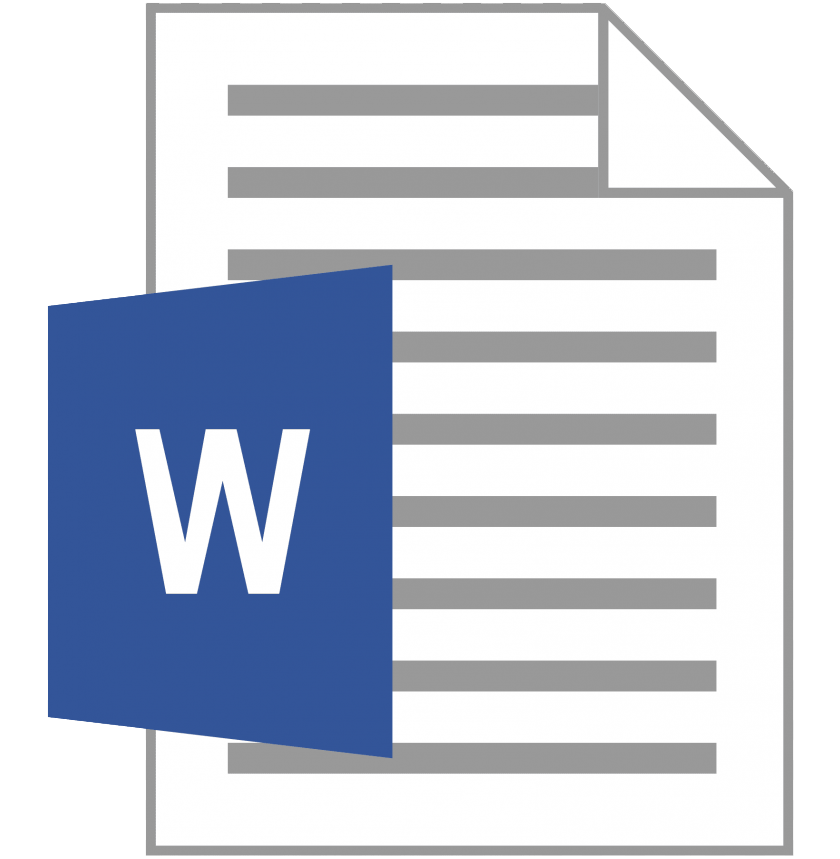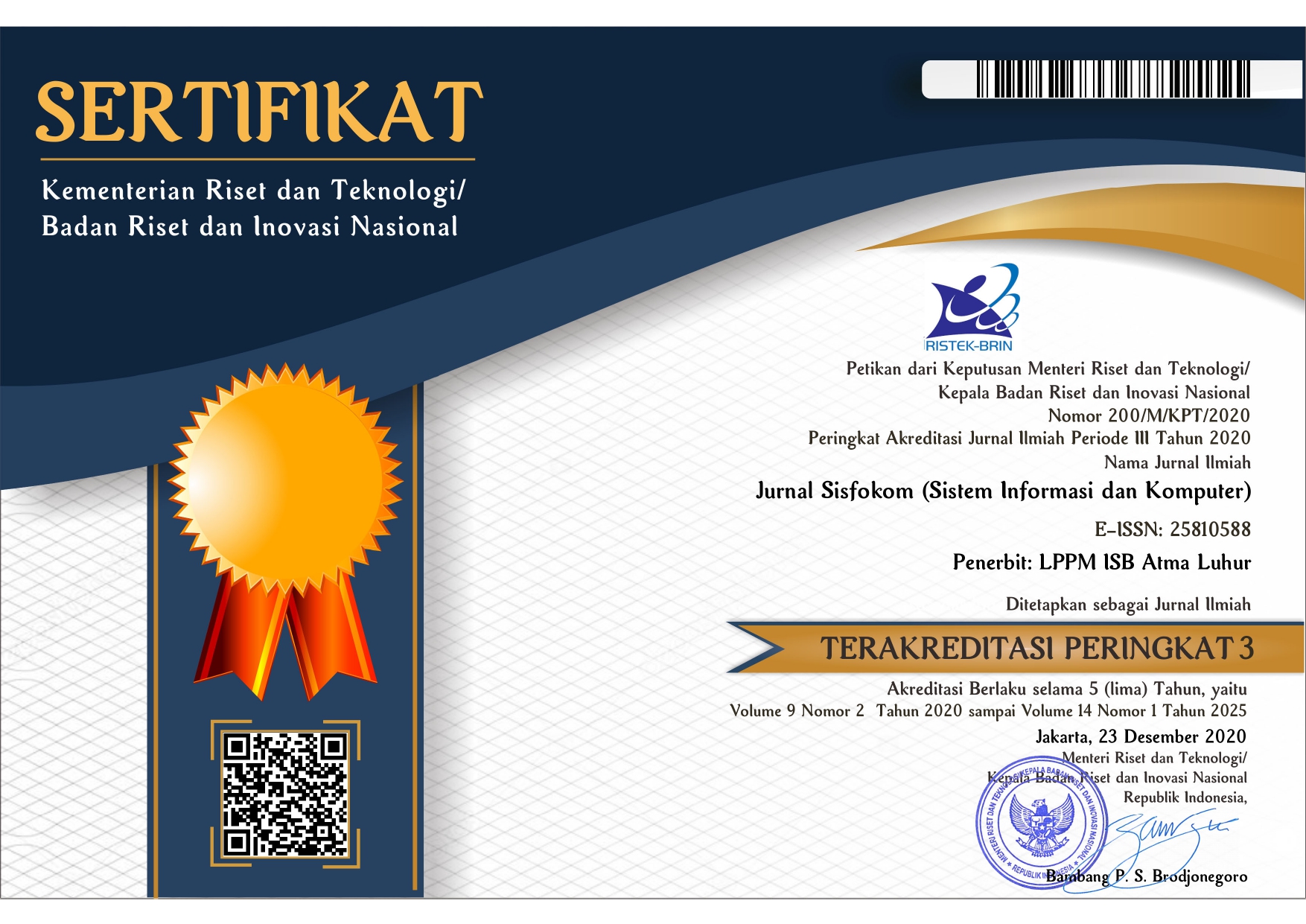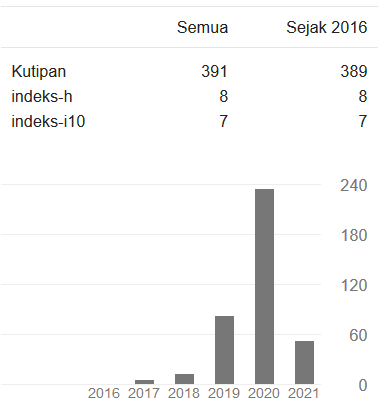PENERAPAN METODE ADABOOST UNTUK MENGOPTIMASI PREDIKSI PENYAKIT STROKE DENGAN ALGORITMA NAÏVE BAYES
DOI:
https://doi.org/10.32736/sisfokom.v9i3.1023Keywords:
Stroke, Machine Learning, Naïve Bayes, AdaboostAbstract
Stroke is the deadliest disease in the world. Creating injury to this nervous system because of this requires special attention in its treatment. The development of the Industrial Revolution Era 4.0 technology and health science can collaborate to become something beneficial by using machine learning. Currently the benefits are used in predicting several diseases to be anticipated. In particular, stroke using adaboost optimization with naïve Bayes which can provide an accuracy of 0.986 has an Excellent classification diagnosis with 70/30 split data. The previous accuracy without using optimization is 0.976. The result of this accuracy is used by health experts in making good decisions in the field of nursing and medicine. In order to speed up the results of diagnosis to stroke patients.References
B. C. V Campbell and P. Khatri, “Stroke,” Lancet, vol. 396, no. 10244, pp. 129–142, Jul. 2020, doi: 10.1016/S0140-6736(20)31179-X.
G. J. Hankey, “Stroke,” The Lancet. 2017, doi: 10.1016/S0140-6736(16)30962-X.
T. Ouyang and S. Sabat, “Stroke,” in Radiology Fundamentals: Introduction to Imaging & Technology, 2020.
D. W. Nugraha, A. Y. E. Dodu, and N. Chandra, “Klasifikasi Penyakit Stroke Menggunakan Metode Naive Bayes Classifier (Studi Kasus Pada Rumah Sakit Umum Daerah Undata Palu),” semanTIK, vol. 3, no. 2, pp. 13–22, 2017.
J. Heo, J. G. Yoon, H. Park, Y. D. Kim, H. S. Nam, and J. H. Heo, “Machine Learning–Based Model for Prediction of Outcomes in Acute Stroke,” Stroke, vol. 50, no. 5, pp. 1263–1265, May 2019, doi: 10.1161/STROKEAHA.118.024293.
V. Adelina and R. et All, “Klasifikasi Tingkat Risiko Penyakit Stroke Menggunakan Metode GA-Fuzzy Klasifikasi Tingkat Risiko Penyakit Stroke Menggunakan Metode GA- Fuzzy Tsukamoto,” J. Pengemb. Teknol. Inf. dan Ilmu Komput. Univ. Brawijaya, vol. 2, no. September, pp. 3015–3021, 2018.
I. Cholissodin, F. Farisuddin, and E. Santoso, “Klasifikasi Tingkat Resiko Stroke Menggunakan Improved Particle Swarm Optimization dan Support Vector Machine,” Konf. Nas. Sist. Inf. 2016, STT Ibnu Sina, no. February, pp. 11–13, 2017.
K. Shameer, K. W. Johnson, B. S. Glicksberg, J. T. Dudley, and P. P. Sengupta, “Machine learning in cardiovascular medicine: are we there yet?,” Heart, vol. 104, no. 14, pp. 1156–1164, Jul. 2018, doi: 10.1136/heartjnl-2017-311198.
M. S. Singh and P. Choudhary, “Stroke prediction using artificial intelligence,” in 2017 8th Annual Industrial Automation and Electromechanical Engineering Conference (IEMECON), 2017, pp. 158–161, doi: 10.1109/IEMECON.2017.8079581.
B. Letham, C. Rudin, T. H. McCormick, and D. Madigan, “Interpretable classifiers using rules and bayesian analysis: Building a better stroke prediction model,” Ann. Appl. Stat., 2015, doi: 10.1214/15-AOAS848.
D. S. Susilawati and D. Riana, “Optimization the Naive Bayes Classifier Method to diagnose diabetes Mellitus,” IAIC Trans. Sustain. Digit. Innov., vol. 1, no. 1, pp. 78–86, Nov. 2019, doi: 10.34306/itsdi.v1i1.21.
K. Vembandasamy, R. Sasipriya, and E. Deepa, “Heart Diseases Detection Using Naive Bayes Algorithm,” Int. J. Innov. Sci. Eng. Technol., 2015.
I. Lishania, R. Goejantoro, and N. Nasution, “Perbandingan Klasifikasi Metode Naive Bayes dan Metode Decision Tree Algoritma ( J48 ) pada Pasien Penderita Penyakit Stroke di RSUD Abdul Wahab Sjahranie Samarinda Comparison of the Classification for Naive Bayes Method and the Decision Tree Algorithm ( ,” vol. 10, pp. 135–142, 2019.
D. Berrar, “Bayes’ Theorem and Naive Bayes Classifier,” in Encyclopedia of Bioinformatics and Computational Biology, Elsevier, 2019, pp. 403–412.
M. Hambali, Y. Saheed, T. Oladele, and M. Gbolagade, “ADABOOST Ensemble Algorithms for Breast Cancer Classification,” J. Adv. Comput. Res., 2019.
Q. Huang, Y. Chen, L. Liu, D. Tao, and X. Li, “On Combining Biclustering Mining and AdaBoost for Breast Tumor Classification,” IEEE Trans. Knowl. Data Eng., 2020, doi: 10.1109/TKDE.2019.2891622.
Downloads
Published
Issue
Section
License
The copyright of the article that accepted for publication shall be assigned to Jurnal Sisfokom (Sistem Informasi dan Komputer) and LPPM ISB Atma Luhur as the publisher of the journal. Copyright includes the right to reproduce and deliver the article in all form and media, including reprints, photographs, microfilms, and any other similar reproductions, as well as translations.
Jurnal Sisfokom (Sistem Informasi dan Komputer), LPPM ISB Atma Luhur, and the Editors make every effort to ensure that no wrong or misleading data, opinions or statements be published in the journal. In any way, the contents of the articles and advertisements published in Jurnal Sisfokom (Sistem Informasi dan Komputer) are the sole and exclusive responsibility of their respective authors.
Jurnal Sisfokom (Sistem Informasi dan Komputer) has full publishing rights to the published articles. Authors are allowed to distribute articles that have been published by sharing the link or DOI of the article. Authors are allowed to use their articles for legal purposes deemed necessary without the written permission of the journal with the initial publication notification from the Jurnal Sisfokom (Sistem Informasi dan Komputer).
The Copyright Transfer Form can be downloaded [Copyright Transfer Form Jurnal Sisfokom (Sistem Informasi dan Komputer).
This agreement is to be signed by at least one of the authors who have obtained the assent of the co-author(s). After submission of this agreement signed by the corresponding author, changes of authorship or in the order of the authors listed will not be accepted. The copyright form should be signed originally, and send it to the Editorial in the form of scanned document to sisfokom@atmaluhur.ac.id.






